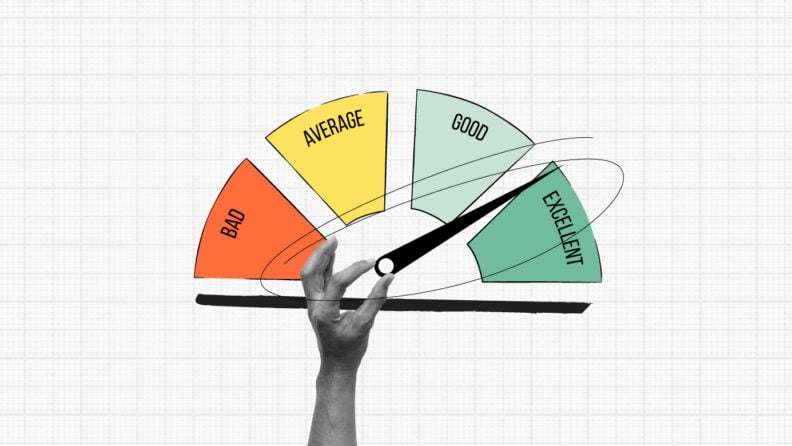Measuring employee performance, rewarding successes, and identifying areas for improvement are vital for effective performance management.
Research from McKinsey found that companies that focus on their people’s performance are 4.2 times more likely to outperform their peers, realizing an average of 30 percent higher revenue growth and experiencing attrition five percentage points lower.
So, now we've established why performance management is important, how do you measure employee performance and hopefully improve it?
How To Measure Employee Performance
Ideally, measuring employee performance should be a continuous process based on a foundation of clear expectations and goals with a culture of openness and trust.
1. Set relevant goals and KPIs
Measurement requires a target or benchmark, so it’s important to set clear, measurable goals and expectations for each role and team in alignment with organizational objectives.
Goals are important for creating alignment, ownership, and improving productivity. Indeed, setting performance expectations has been found to increase productivity by 15%.
Goal setting is a vast topic, with many organizations leaning into popular frameworks such as SMART (Specific, Measurable, Achievable, Relevant, Time-bound) or OKRs (Objectives and Key Results) to help set well-defined goals.
For maximum effectiveness, it’s best to start with overarching organizational goals and cascade them down through departments to managers to individuals.
Here’s an example:
Company objective:
- Increase overall customer satisfaction score by 20% by the end of the year.
Departmental goals:
- Customer support team: Reduce average response time to customer inquiries by 30% within six months.
- Product development team: Decrease product defect rate by 15% over the next year.
- Sales team: Improve customer onboarding process to achieve a 10% reduction in onboarding time by the end of Q3.
- Marketing team: Increase customer engagement on social media by 25% by promoting user tips and responding to inquiries.
Individual goals (examples):
- Customer support agent: Respond to at least 95% of customer emails within 24 hours each month.
- Product engineer: Identify and implement three improvements to the product manufacturing process to reduce defects.
- Sales rep: Reach out to new customers within one business day to guide them through the onboarding materials and answer initial questions.
Cascading the company-wide goal down through departments, teams, and individuals (cascading goals) gives everyone a clear line of sight to how their efforts contribute to the company’s success, which helps boost motivation.
Assessing team performance, and tying it to individual and departmental performance, will support a culture of accountability and clear vision for what high performance looks like.
You can check out our pick of the best goal setting software to make the process of setting and tracking goals more efficient.
2. Conduct formal performance reviews
Formal performance reviews provide a structured opportunity to assess employee performance against established goals and KPIs.
Typically conducted annually or semi-annually, they draw on multiple inputs including data-driven insights, self-assessments, and manager evaluations.
Incorporating 360-degree feedback adds depth by capturing perspectives from peers and cross-functional collaborators.
These reviews are a space for reflection on performance, recognition of achievements, and realignment on future goals and performance expectations.
When done consistently and thoughtfully, they reinforce accountability, support growth, and guide performance-related decisions.
Read more in Mariya Hristova’s excellent article performance reviews best practices.
3. Continuous performance management
While annual reviews have their place, research from Betterworks found that organizations that adopted continuous performance management practices reported outperforming or significantly outperforming their competition at a 24% higher rate.
This means more frequent, less formal, performance check-ins, real-time feedback (or as close as), and goal adjustments to keep employees aligned and motivated throughout the year.
CPM helps measure performance at regular intervals and keeps it top of mind, relieving some of the pressure from formal performance reviews.
11 Best Methods For Measuring Employee Performance
Performance is usually attached to some kind of metric—cold hard numbers. But it’s also important to gather more qualitative data to help measure performance, corroborate the numbers, and provide context.
Here are some quantitative and qualitative methods of measuring performance.
1. Key performance indicators (KPIs)
Using KPIs to measure employee performance provides a structured, data-driven approach to evaluate how well employees are meeting the specific requirements of their roles.
KPIs should reflect the core responsibilities and outcomes expected in an employee’s role.
For instance, a sales representative might have KPIs like “monthly sales revenue” and “new customer acquisitions,” while a customer service agent might have KPIs like “average response time” and “customer satisfaction score.”
Defining relevant KPIs ensures that the performance measures are directly tied to the employee’s day-to-day work and the company's strategic goals.
Each KPI should have a target or benchmark to provide a performance standard. For example:
- Monthly sales revenue target of $50,000.
- Customer satisfaction score target of 90%.
- Average response time target of under 24 hours. These targets make it clear what success looks like and provide employees with specific, measurable goals to work toward.
2. OKRs (objectives and key results)
OKRs (objectives and key results) can be a powerful tool for measuring employee performance by aligning individual contributions with team and organizational goals.
Each employee sets goals that are ambitious, time-bound, and aligned with broader team or company goals.
For example, if the company’s objective is to “increase customer satisfaction,” a customer support employee might have an objective like, “Enhance response quality and reduce resolution time for customer inquiries.”
Key Results are the specific, measurable outcomes that indicate progress toward each objective. They provide a clear, quantifiable way to track success. For instance, for the objective above, Key Results might include:
- Achieving a customer satisfaction score of 90% or higher.
- Reducing average response time from 24 hours to 12 hours.
- Resolving 85% of customer inquiries on the first contact.
For more, check out our guide to OKRS and our pick of the best OKR software.
3. SMART goals
SMART stands for measurable, attainable, relevant, and time-bound. This approach ensures that goals are clear, actionable, and aligned with both individual and organizational objectives.
Each SMART goal aims to be clear and specific, leaving no ambiguity about what needs to be accomplished.
For example, instead of a vague goal like “improve sales,” a specific goal would be, “Increase monthly sales by 20% through new client outreach.”
This specificity gives employees a concrete target and prevents misunderstandings about what success looks like.
To track progress and success, each goal should include a quantifiable metric. For instance, “Close 10 new sales deals by the end of the quarter” is a measurable goal, whereas “Get more sales” is not.
For more, check out our guide to creating SMART goals.
4. Management by objectives (MBO)
Using MBO (Management by Objectives) to measure employee performance is a goal-setting process where employees and managers collaboratively set specific, measurable objectives that align with the organization's broader goals.
In MBO, managers and employees work together to define specific objectives for the employee’s role. These objectives should be directly aligned with team and organizational goals, making it clear how each individual’s work contributes to overall success.
For instance, a marketing manager might set an objective to “increase lead generation by 20% over the next quarter” to support a company goal of expanding market share.
Each objective should be specific, measurable, and have a clear deadline. For example:
- “Achieve a 15% increase in customer satisfaction by year-end.”
- “Launch three new product features by Q3.”
- “Reduce operational costs by 10% within six months.” This approach provides concrete performance targets and sets a clear timeline for achievement, making it easier to assess progress objectively.
5. Graphic rating scales
Graphic rating scales are a straightforward method for measuring employee performance by rating individuals on various job-related criteria.
Typically, these scales range from poor to excellent (e.g., a 5-point scale) and cover key performance dimensions like quality of work, communication skills, teamwork, or reliability.
For example, for a customer service representative, important criteria might include “communication skills,” “problem-solving,” and “timeliness.”
By defining these criteria, managers can focus evaluations on relevant competencies that reflect the employee’s performance.
Then create a clear performance rating scale. Each criterion is rated on a numeric or descriptive scale, usually ranging from 1 to 5, with descriptors like:
- 1 - Poor: Rarely meets expectations.
- 3 - Satisfactory: Meets most expectations.
- 5 - Excellent: Consistently exceeds expectations. These ratings provide a structured way to evaluate performance on each criterion, making it easy for managers to score employees consistently.
6. 360-degree feedback
360-degree feedback is a comprehensive performance evaluation method where employees receive feedback from multiple sources, including peers, subordinates, managers, and sometimes even clients.
Often combined with the graphic rating scale above, the aim is to provide a well-rounded view of an employee’s performance, focusing on areas like communication, teamwork, leadership, and other interpersonal skills.
7. Self-assessment
Self-assessment is a performance evaluation method where employees reflect on and evaluate their own work, accomplishments, and areas for improvement over a set period.
Again often combined with the graphic rating scale, this process is designed to encourage self-awareness, accountability, and personal development, allowing employees to take an active role in their growth.
Managers usually provide structured questions or guidelines to help employees focus on key areas of their performance. These prompts often include questions like:
- “What are your most significant accomplishments this period?”
- “Which goals did you meet, and which were challenging?”
- “What areas do you want to improve, and how do you plan to do so?”
Tip: Tools like performance management software have features to capture employee feedback and work it into performance reviews.
8. Performance reviews
Performance reviews are formal evaluations where managers assess an employee’s achievements, areas for improvement, and overall contribution over a specific period (often annually or semi-annually).
They provide structured feedback and are typically a key component of most performance management systems.
Much-maligned, there’s an art to these you can discover in Liz Lockart Lance’s excellent article how to conduct performance reviews.
9. Behaviorally anchored rating scales (BARS)
BARS is a performance evaluation method that combines quantitative ratings with specific behavioral examples to create a more objective, detailed measurement of employee performance.
Each rating on the scale is anchored by examples of behaviors that represent different performance levels.
The first step in creating a behaviorally anchored rating scale is identifying the essential competencies or skills required for the role.
For example, for a customer service representative, competencies might include “customer communication,” “problem-solving,” and “product knowledge.”
For each competency, the next step is to define specific behaviors that represent various levels of performance on a rating scale (typically 1 to 5).
These descriptors are detailed examples that illustrate what performance at each level looks like.
For instance, in “customer communication,” a 5 might describe a rep who “consistently addresses customer concerns professionally and maintains a calm, respectful tone,” while a 2 might describe someone who “sometimes communicates effectively but occasionally uses language that may frustrate customers.”
Each behavior is assigned a rating, often from “poor” to “excellent,” with each level anchored by specific examples of observable actions.
The idea is that this structure allows managers to score employees on each competency based on the behaviors they exhibit, minimizing subjectivity.
The specificity of the behaviors for each rating level helps managers make consistent, objective evaluations.
10. Productivity metrics
Productivity metrics are quantitative measures used to assess how efficiently employees perform their work.
These metrics are often directly tied to output and help evaluate an employee’s effectiveness, efficiency, and consistency.
For example, in a sales role, metrics like “number of calls a day” or “number of leads generated" might be relevant, while in a production role, “units produced per hour” or “error rate” might be more appropriate.
11. Quality of work
Quality of work metrics are performance measures that focus on the accuracy, thoroughness, and overall standard of an employee’s output rather than just the quantity.
These metrics are especially useful for roles where attention to detail, precision, and excellence in execution are critical.
For instance, in a manufacturing role, metrics might include “defect rate” or “precision of assembly”, whereas in a developer role it might include “number of bugs” or “load time”.
Useful Metrics To Help Measure Employee Performance
Here are some useful examples of metrics you can use to measure employee performance. When combined, these categories give a balanced view—covering hard numbers (productivity/quality), operational effectiveness (efficiency), and softer but equally crucial elements (collaboration, innovation, engagement).
1. Productivity metrics
Focus on output and efficiency.
- Tasks completed per period: Number of tasks, projects, or tickets finished in a day/week/month.
- Sales volume/revenue generated: For sales roles, revenue closed or deals secured.
- Utilization rate: Percentage of time spent on billable or value-adding activities versus idle or administrative work.
- Adherence to deadlines: Ratio of tasks completed on time vs. delayed.
2. Quality of work metrics
These, I’d argue, are more illustrative and useful than productivity metrics as Goodhart’s law states that when a metric, such as closing tickets, “becomes a target, it ceases to be a good measure". It’s the classic quality vs quantity debate.
- Error rate/defect rate: Percentage of work that requires correction or results in customer complaints.
- First-time resolution rate: How often employees resolve issues correctly on the first attempt.
- Customer satisfaction scores (CSAT/NPS): Ratings from customers, clients, or stakeholders on the quality of interaction or deliverables
- Peer reviews or quality audits: Evaluation results from internal quality checks.
3. Efficiency metrics
Look at the relationship between time/resources used and results.
- Turnaround time: Time taken to complete tasks from start to finish.
- Cost per output unit: Cost of labor versus value delivered (e.g., cost per sale).
- Attendance and punctuality: On-time arrivals, presence in key meetings, and minimal absenteeism.
- Time to competency: How quickly new employees reach full productivity.
4. Collaboration and teamwork metrics
Assess contribution to team success and organizational culture.
- Cross-functional project participation: Involvement and effectiveness in multi-team initiatives.
- Knowledge sharing frequency: Contributions to documentation, training, or mentorship.
- Team goal achievement rate: Extent to which collective goals are met with their input.
5. Innovation and initiative metrics
Capture proactive contributions and problem-solving ability.
- Process improvement suggestions implemented: Number/impact of ideas adopted.
- New skills learned / certifications earned: Investment in self-development that benefits the role
- Project leadership or initiative ownership: Taking responsibility beyond job description.
- Problem-solving effectiveness: Documented solutions that reduce inefficiencies or enhance outcomes.
6. Engagement and behavioral metrics
Indicate commitment, motivation, and organizational alignment.
- Employee Net Promoter Score (eNPS): Willingness to recommend the company as a workplace.
- Participation in company activities: Training, town halls, and engagement programs.
- Goal alignment achievement: Degree to which personal goals align with company OKRs/KPIs.
- Manager/peer recognition frequency: Positive acknowledgment received from colleagues.
7. Learning and development metrics
L&D metrics are increasingly important because they link employee growth to company performance.
- Course completion rate (Participation & Engagement)
- Shows how committed employees are to finishing what they start.
- High completion rates = effective program design and relevance.
- Skill gap reduction (Knowledge & Skill Acquisition)
- Measures before-and-after improvement in target skills.
- Directly shows whether training is actually working.
- Self-reported confidence levels
- Employees rate their confidence in applying new skills post-training.
- Encourages reflection on their growth journey and surfaces areas for further support.
- Career progression rate
- Tracks whether learning leads to promotions, new responsibilities, or lateral moves.
- Directly ties personal development to career growth, making L&D feel worthwhile.
Best Practices For Measure Employee Performance
Here are some best practices to ensure you’re measuring the right things and fueling growth and development:
1.Clearly aligned goals and expectations
- Use SMART goals: Ensure objectives are Specific, Measurable, Achievable, Relevant, and Time-bound.
- Tie performance metrics to company OKRs/KPIs: This makes individual contributions meaningful in the bigger picture
- Communicate expectations early: Employees should know what success looks like and how it’s measured.
2. Use a balanced mix of metrics
- Blend quantitative and qualitative: Combine hard numbers (sales, output, deadlines) with softer measures (collaboration, innovation, cultural fit).
- Measure outcomes, not just activity: Focus on impact (results delivered) rather than hours worked.
- Adapt metrics by role: Customer-facing roles may prioritize satisfaction scores, while creative roles may emphasize innovation.
3. Collect feedback from multiple sources
- 360-degree feedback: Gather input from peers, managers, direct reports, and even clients when relevant.
- Self-assessment: Encourages reflection and ownership of performance.
- Manager observation + data: Blend qualitative insights with performance metrics for a fuller picture.
4. Ensure fairness and consistency
- Standardize criteria across similar roles: Avoid bias by applying the same standards.
- Context matters: Adjust expectations for role complexity, workload, or external factors (e.g., market downturns).
- Regular calibration sessions: Managers should align on what “good performance” looks like across teams.
5. Make it ongoing, not just annual
- Continuous feedback loops: Replace (or supplement) annual reviews with quarterly or monthly check-ins.
- Use real-time data: Track key performance indicators throughout the year, not retroactively.
- Micro-feedback: Short, timely notes on specific tasks can be more actionable than broad reviews.
6. Focus on development, not just evaluation
- Highlight strengths and growth opportunities: Balance constructive feedback with recognition.
- Link feedback to L&D opportunities: Recommend training, mentoring, or stretch assignments.
- Track progress over time: Use past reviews as benchmarks for future improvement.
7. Leverage technology and tools
- Performance management software: Centralizes goals, metrics, and feedback.
- Analytics dashboards: Provide transparency into performance trends.
- Pulse surveys: Measure engagement, confidence, and morale alongside hard metrics.
Why Measuring Employee Performance Is Important
Measuring employee performance might sound like a boring HR thing, but it's actually super valuable—for both the company and the employees themselves!
It's a key factor in driving employee performance overall and helping all parties identify what needs to happen next.
Here’s why it matters:
Keeps everyone on the same page
Tracking performance helps keep individual and team efforts with the company’s goals, so everyone’s rowing in the same direction.
If a team’s goals suddenly seem misaligned with industry trends or market demands, or there’s a change in strategy, leaders can adjust priorities and refocus the team before any impact on productivity or market relevance.
Further, when employees understand how their work fits into the bigger picture, it’s a win for productivity—and they can see how they’re part of the company’s success story.
Makes promotion and pay decisions fairer
Making decisions about promotions and raises can be tricky. Objective performance data helps take the guesswork out of it, allowing leaders to make decisions based on real achievements rather than gut feeling.
It also builds transparency and trust around career growth and rewards.
Highlights strengths and opportunities to grow
Measuring performance isn’t just about spotting performance gaps and what needs adjustment or improvement; it shines a light on what each person does best.
By spotting strengths and areas for development, managers can give targeted support, so employees get better and better at what they do.
It also helps identify high-potential employees who might be future leaders, which is crucial for effective succession planning and long-term growth.
Clarifies accountability
Clear performance measures help everyone know what they’re responsible for. This boosts focus and minimizes misunderstandings about roles, ensuring everyone is contributing their best.
Improves productivity by tackling bottlenecks
By identifying areas where employees are struggling, organizations can proactively support them with resources or adjust goals or workflows, making everyone’s job a bit easier and boosting efficiency.
Enhances satisfaction and retention
When employees feel valued and supported in their growth, they’re more likely to stick around. Acknowledging achievements and showing a commitment to their development boosts morale and loyalty.
Subscribe To The People Managing People Newsletter
For more insight on performance management, subscribe to our weekly newsletter for HR and business leaders. You’ll receive all our latest content to help you grow in your career and make greater impact in your org.






